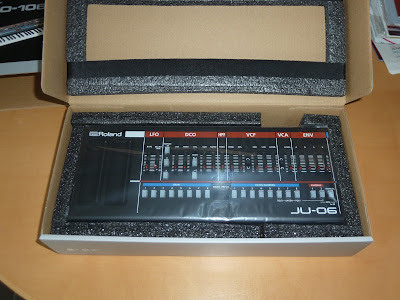Der Roland JU-06 ist eine gelungene Nachbildung eines Klassikers der analogen Ära: des Juno-106 von Roland. Wie bei einem echten Analogsynthesizer gibt es beim JU-06 für jeden Klang-Parameter einen eigenen Regler, was zum Fummeln und Experimentieren einlädt. Trotz seiner nur 4-stimmigen Polyphonie ist der JU-06 ein vollwertiger (quasi-)analoger Synthesizer, der auch dank des günstigen Preises seinen Weg in jedes Musikstudio finden sollte.
Als einer, der die analoge Synthesizer-Ära noch miterlebt hatte, konnte ich nicht widerstehen, als Roland seine Boutique-Linie angekündigt hatte. Ich musste einen haben! Ich hatte mir vor dem Kauf diverse YouTube-Videos über alle Boutique-Module angeschaut, und natürlich hat es mir das Top-Modell, der Jupiter-Klon, besonders angetan. Da ich aber in den 80ern in den Kellern der Musikalienläden an diversen Juno-60 herumgeklimpert hatte, während allfällige Jupiters vorsorglich ausgeschaltet waren, liegt mir der Juno-Boutique trotzdem etwas näher. Daher habe ich bewusst einen JU-06 gekauft.
Die meisten Testberichte bestätigen, dass der Sound des JU-06 dem seines Vorbildes sehr nahekommt. Ich selber kann nur sagen, dass der Sound grossartig ist: warme Pads, grelle Bläser-Klänge, aggressive Bässe... wer die Presets durchklickt bekommt schon rasch einen guten Überblick über die Bandbreite der Synthesizerklänge, derer der JU-06 fähig ist. Und im Manual-Modus zeigt sich erst, wie schnell und einfach sich Klänge auf einem analogen Synthesizer komponieren lassen.
Ich besitze einen Yamaha DX7 und glaube daher, die Vorzüge einer hands-on Bedienung einigermassen zuverlässig beurteilen zu können, die "echte" Analog-Synthesizer dadurch bieten, dass ein eigener Regler für jeden Klangparameter zur Verfügung steht. Hier ist an den Boutique Modulen nichts auszusetzen. Sie bilden die Benutzer-Oberfläche ihrer Vorbilder getreulich nach und laden geradezu zum Befummeln ... sorry ... Experimentieren ein. Beim JU-06 sind die Reglerwege auch genügend lang, um jenen sweet spot im Klangspektrum zu treffen, den man für seine Kompositionen benötigt.
Da sich die Geräte der Boutique-Line als mehr oder weniger getreue Nachbildungen der analogen Keyboards verstehen, darf man allfällige Einschränkungen auch nicht unbedingt als Mangel verstehen: der Juno-106 hatte nunmal nur einen Oszillator, und beim JX-3P gab es zwar 2 Oszillatoren, aber keine Pulsweiten-Modulation. Insofern ist die Nachbildung vorbildtreu.
Natürlich ist es schade, dass Roland nicht gleich den ganzen Weg gegangen ist und das Modul 6-stimmig gemacht hat -- wie das Original. Aber ich erachte auch diesen Makel als gerade noch verkraftbar. Wer unbedingt mehr Stimmen braucht, kann ja ein zweites Modul dazukaufen und kommt dann immer noch massiv billiger, als wenn man irgendwo einen "echten" Juno zum Liebhaberpreis erstehen muss.
Wer sein Modul vor allem mit dem Sequenzer seines Software-Aufnahmestudios bespielt, wird kaum je an die Grenzen stossen. Ich habe einen Synth-Song spurweise via MIDI eingespielt (Bass, Pad, Stakkato-Akkord und Arpeggio) und das Resultat tönt phantastisch. Die vierfache Polyphonie reicht dann vollkommen. Beim direkten Bespielen mit dem Keyboard fällt halt vielleicht schon mal der eine oder andere Ton über Bord, vor allem wenn man Akkorde "legato" spielt.
Zu bedenken ist vielleicht auch noch, dass die Ausgangsbuchse ein eher untypisches 3.5mm Format aufweist. Man sollte daher nicht vergessen, gleich ein passendes Adapterkabel mitzubestellen. Dasselbe gilt auch für das MikroB-USB-Adapterkabel, das man für den batterielosen Betrieb benötigt, und das leider nicht im Lieferumfang enthalten ist.
Wer in den analogen Synthesizer-Klängen der 80er Jahre schwelgen möchte, kann mit einem Gerät aus der Boutique-Linie nicht gross daneben hauen. Ich jedenfalls würde den JU-06 nicht mehr hergeben und spiele bereits mit dem Gedanken, noch einen JX-03 dazu zu kaufen...



